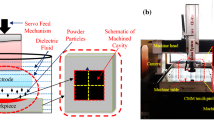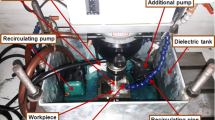Abstract
The challenging characteristics of Inconel 617 (IN617), such as its modest modulus of elasticity, heightened chemical reactivity, and low thermal conductivity, pose difficulties in employing conventional machining methods for this material. This complexity is further amplified when considering the specific requirements for applications in aerospace. Consequently, electric discharge machining (EDM) emerges as a preferred approach for working with this alloy. However, inherent challenges within EDM, specifically electrode wear rate (EWR) and dimensional overcuts, limit its efficacy. To address these issues, a comprehensive exploration of the potential of powder-based additives in waste cooking oil (WCO) against cryogenically treated brass electrode material has been undertaken. The investigation holds pivotal importance because the careful choice of an optimal dielectric plays a significant role in affecting the heat input to the electrode, thereby influencing the melting/vaporization and tool wear of the electrode. It is essential to highlight that these considerations have not been adequately addressed in the current body of literature. The experimentation employs the Response Surface Methodology (RSM) experimental design. The findings indicate that the shallow cryogenically treated (SCT) brass electrode exhibited exceptional performance, yielding the lowest values for electrode wear rate (EWR) at 1.49 mg/min and dimensional overcuts (OC) at 0.01 mm. These results are notably superior, surpassing the least values obtained with the deep cryogenically treated (DCT) brass electrode, showcasing a 202.68% improvement in EWR and a 2.33% improvement in OC.











Similar content being viewed by others
Data availability
Not applicable.
References
Ji MK, Lee MS, Hyun YT, Jun TS (2023) Effect of holding time between cryogenic treatment and tempering process on microstructural and mechanical properties of Ti-6Al-4V alloy. Mater Today Commun 36:106514. https://doi.org/10.1016/J.MTCOMM.2023.106514
Dong Y, Li G, Wang Y, et al (2021) Study on the effective discharge energy mechanism of vertical ultrasonic vibration assisted EDM processing. 101177/09544054211028527 236:453–461. https://doi.org/10.1177/09544054211028527
Xu J, Li M, Zhong J et al (2022) Process parameter modeling and multi-response optimization of wire electrical discharge machining NiTi shape memory alloy. Mater Today Commun 33:104252. https://doi.org/10.1016/J.MTCOMM.2022.104252
Gupta A, Kumar H, Nagdeve L, Arora PK (2020) EDM parametric study of composite materials: A review. Evergreen 7:519–529. https://doi.org/10.5109/4150471
Ubaid AM, Dweiri FT, Aghdeab SH, Al-Juboori LA (2018) Optimization of electro discharge machining process parameters with fuzzy logic for stainless steel 304 (ASTM A240). J Manuf Sci Eng Trans ASME 140. https://doi.org/10.1115/1.4038139/384008
Tanveer A, Kapoor SG, Mujumdar SS (2019) Modeling of material removal in atomized dielectric-based electrical discharge machining (EDM). ASME 2019 14th Int Manuf Sci Eng Conf MSEC 2019 2:. https://doi.org/10.1115/MSEC2019-3025
Jafarian F (2020) Electro discharge machining of Inconel 718 alloy and process optimization. Mater Manuf Process 35:95–103. https://doi.org/10.1080/10426914.2020.1711919
Xu X, Hao Y, Dong R et al (2023) Effect of undercooling on microstructure evolution of Cu based alloys. J Alloys Compd 935:167998. https://doi.org/10.1016/J.JALLCOM.2022.167998
Cao P, Tong H, Li Y, Chen J (2023) Interelectrode gas–liquid-solid three-phase flow analysis and simulation for drilling holes with high aspect ratio by micro-EDM. Int J Adv Manuf Technol 128:5261–5276. https://doi.org/10.1007/S00170-023-12220-4
Chandrashekarappa MPG, Kumar S, Jagadish, et al (2021) Experimental analysis and optimization of EDM parameters on HcHcr steel in context with different electrodes and dielectric fluids using hybrid taguchi-based PCA-utility and CRITIC-utility approaches. Met, 11, 3:419. https://doi.org/10.3390/MET11030419
Kumar A, Maheshwari S, Sharma C, Beri N (2011) Analysis of machining characteristics in additive mixed electric discharge machining of nickel-based super alloy inconel 718. Mater Manuf Process 26:1011–1018. https://doi.org/10.1080/10426914.2010.527415
Kumar A, Maheshwari S, Sharma C, Beri N (2010) Research developments in additives mixed electrical discharge machining (AEDM): a state of art review. Mater Manuf Process 25:1166–1180. https://doi.org/10.1080/10426914.2010.502954
Liu Z, Lu Y, Wang Y et al (2021) Polarization Modulation at last quantum barrier for high efficiency AlGaN-based UV LED. IEEE Photonics J 14:1–8. https://doi.org/10.1109/JPHOT.2021.3139265
Tang X, Lu Y, Lin R et al (2023) Flexible self-powered DUV photodetectors with high responsivity utilizing Ga2O3/NiO heterostructure on buffered Hastelloy substrates. Appl Phys Lett 122:121101. https://doi.org/10.1063/5.0146030/2880825
Wang C, AlQatari F, Khandelwal V et al (2023) Origin of interfacial charges of Al2O3/Si and Al2O3/GaN heterogeneous heterostructures. Appl Surf Sci 608:155099. https://doi.org/10.1016/J.APSUSC.2022.155099
Kumar S, Khedkar NK, Jagtap B, Singh TP (2017) The effects of cryogenic treatment on cutting tools. IOP Conf Ser Mater Sci Eng 225:012104. https://doi.org/10.1088/1757-899X/225/1/012104
Harsha S, Dasharath SM (2021) Effect of cryogenic heat treatment & ageing on ultra fine grained aluminium–lithium alloy- a review. Mater Today Proc 45:338–348. https://doi.org/10.1016/J.MATPR.2020.10.1009
Dong N, Sun L, Ma H, Jin P (2021) Effects of cryogenic treatment on microstructures and mechanical properties of Mg-2Nd-4Zn alloy. Mater Lett 305:130699. https://doi.org/10.1016/J.MATLET.2021.130699
Özdemir Z (2021) Shallow cryogenic treatment (SCT) effects on the mechanical properties of high cr cast iron: low-carbon cast steel bimetallic casting. Int J Met 15:952–961. https://doi.org/10.1007/S40962-020-00532-0
Senthilkumar D, Rajendran I (2011) Influence of shallow and deep cryogenic treatment on tribological behavior of En 19 steel. J Iron Steel Res Int 18:53–59. https://doi.org/10.1016/S1006-706X(12)60034-X
Choudhary R, Garg H, Prasad M, Kumar D (2017) Effect of cryogenic treatment of tool electrode on the machining performance and surface finish during electrical discharge machining of hastelloy C-4. Mater Today Proc 4:1158–1166. https://doi.org/10.1016/J.MATPR.2017.01.132
Thanigaivelan R, Arunachalam R, Natarajan N (2015) Study on Influence of electrodes in electric discharge machining. Recent Patents. Mech Eng 8(7):161–167
Papazoglou EL, Karmiris-Obratański P, Leszczyńska-Madej B, Markopoulos AP (2021) A study on Electrical Discharge Machining of Titanium Grade2 with experimental and theoretical analysis. Sci Reports 111(11):1–21. https://doi.org/10.1038/s41598-021-88534-8
Ni T, Liu Q, Chen Z et al (2021) An experimental study on processing TC4 with nano particle surfactant mixed micro EDM. Materials (Basel) 14:1–9. https://doi.org/10.3390/ma14206074
Ng PS, Kong SA, Yeo SH (2017) Investigation of biodiesel dielectric in sustainable electrical discharge machining. Int J Adv Manuf Technol 90:2549–2556. https://doi.org/10.1007/S00170-016-9572-6/METRICS
Gowtham Reddy G, Singaravel B, Chandra Shekar K (2019) Experimental investigation of sunflower oil as dielectric fluid in die sinking electric discharge machining process. Mater Sci Forum 969:715–719. https://doi.org/10.4028/WWW.SCIENTIFIC.NET/MSF.969.715
Rouniyar AK, Shandilya P (2020) Optimization of process parameters in magnetic field assisted powder mixed EDM of aluminium 6061 alloy. Proc Inst Mech Eng Part C J Mech Eng Sci 235:2998–3014. https://doi.org/10.1177/0954406220959108
Kassem MGA, Ahmed AMM, Abdel-Rahman HH, Moustafa AHE (2019) Use of Span 80 and Tween 80 for blending gasoline and alcohol in spark ignition engines. Energy Reports 5:221–230. https://doi.org/10.1016/J.EGYR.2019.01.009
Kapoor J, Khamba JS, Singh S (2012) An investigation on wear of shallow cryogenic treated wire in Wedm. Mater Sci Forum 701:31–42. https://doi.org/10.4028/WWW.SCIENTIFIC.NET/MSF.701.31
Mohanty CP, Satpathy MP, Mahapatra SS, Singh MR (2018) Optimization of cryo-treated EDM variables using TOPSIS-based TLBO algorithm. Sadhana - Acad Proc Eng Sci 43:1–18. https://doi.org/10.1007/S12046-018-0829-7
Acknowledgements
The authors appreciate the support from Researchers Supporting Project Number (RSPD2024R702), King Saud University, Riyadh, Saudi Arabia.
Author information
Authors and Affiliations
Contributions
All authors have made notable contributions to this manuscript. All authors have read and agreed to the published version of the manuscript.
Corresponding author
Ethics declarations
Ethical approval
Not applicable.
Consent to participate
Not applicable.
Consent for publication
Not applicable.
Competing interests
The authors declare no competing interests.
Additional information
Publisher’s note
Springer Nature remains neutral with regard to jurisdictional claims in published maps and institutional affiliations.
Rights and permissions
Springer Nature or its licensor (e.g. a society or other partner) holds exclusive rights to this article under a publishing agreement with the author(s) or other rightsholder(s); author self-archiving of the accepted manuscript version of this article is solely governed by the terms of such publishing agreement and applicable law.
About this article
Cite this article
Sana, M., Ishfaq, K., Waseem, M.U. et al. A comparative study on the effect of deep and shallow cryogenic electrodes on tool wear rate and overcut with waste bio-oil in electric discharge machining. Int J Adv Manuf Technol 130, 3307–3322 (2024). https://doi.org/10.1007/s00170-023-12860-6
Received:
Accepted:
Published:
Issue Date:
DOI: https://doi.org/10.1007/s00170-023-12860-6




